Soumya Suvra Ghosal
KITE: Kernelized and Information Theoretic Exemplars for In-Context Learning
Sep 19, 2025Abstract:In-context learning (ICL) has emerged as a powerful paradigm for adapting large language models (LLMs) to new and data-scarce tasks using only a few carefully selected task-specific examples presented in the prompt. However, given the limited context size of LLMs, a fundamental question arises: Which examples should be selected to maximize performance on a given user query? While nearest-neighbor-based methods like KATE have been widely adopted for this purpose, they suffer from well-known drawbacks in high-dimensional embedding spaces, including poor generalization and a lack of diversity. In this work, we study this problem of example selection in ICL from a principled, information theory-driven perspective. We first model an LLM as a linear function over input embeddings and frame the example selection task as a query-specific optimization problem: selecting a subset of exemplars from a larger example bank that minimizes the prediction error on a specific query. This formulation departs from traditional generalization-focused learning theoretic approaches by targeting accurate prediction for a specific query instance. We derive a principled surrogate objective that is approximately submodular, enabling the use of a greedy algorithm with an approximation guarantee. We further enhance our method by (i) incorporating the kernel trick to operate in high-dimensional feature spaces without explicit mappings, and (ii) introducing an optimal design-based regularizer to encourage diversity in the selected examples. Empirically, we demonstrate significant improvements over standard retrieval methods across a suite of classification tasks, highlighting the benefits of structure-aware, diverse example selection for ICL in real-world, label-scarce scenarios.
Does Thinking More always Help? Understanding Test-Time Scaling in Reasoning Models
Jun 04, 2025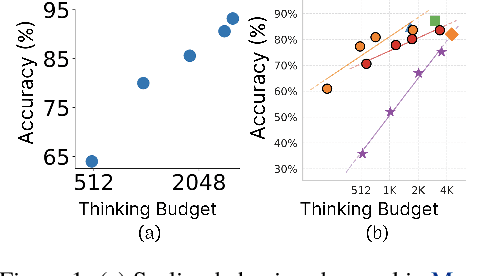
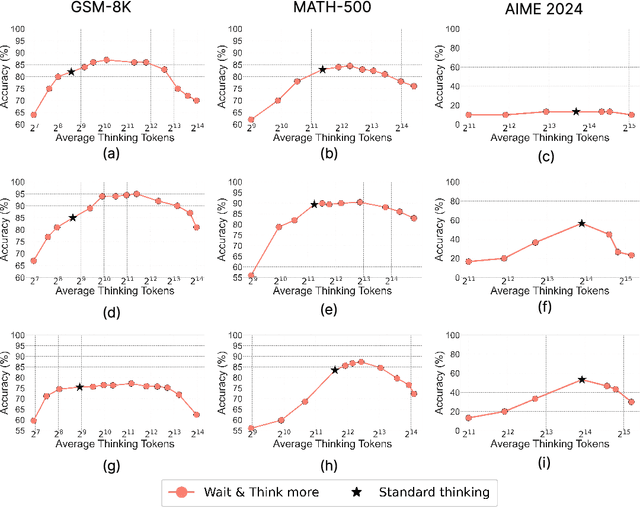
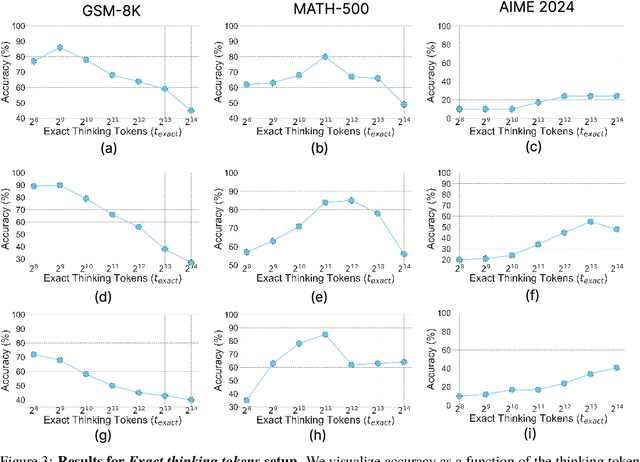
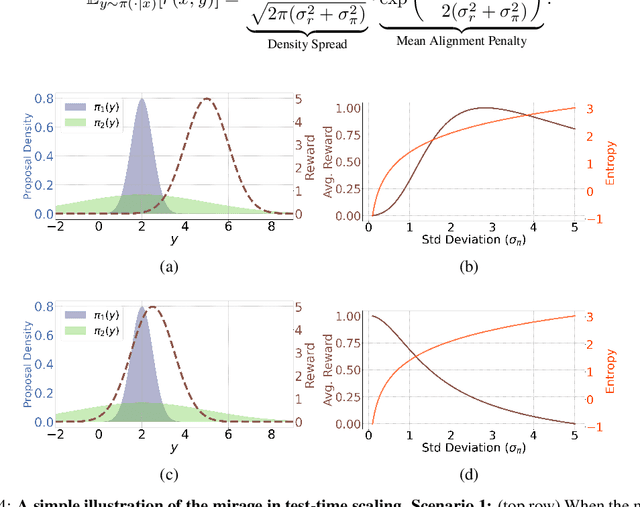
Abstract:Recent trends in test-time scaling for reasoning models (e.g., OpenAI o1, DeepSeek R1) have led to a popular belief that extending thinking traces using prompts like "Wait" or "Let me rethink" can improve performance. This raises a natural question: Does thinking more at test-time truly lead to better reasoning? To answer this question, we perform a detailed empirical study across models and benchmarks, which reveals a consistent pattern of initial performance improvements from additional thinking followed by a decline, due to "overthinking". To understand this non-monotonic trend, we consider a simple probabilistic model, which reveals that additional thinking increases output variance-creating an illusion of improved reasoning while ultimately undermining precision. Thus, observed gains from "more thinking" are not true indicators of improved reasoning, but artifacts stemming from the connection between model uncertainty and evaluation metric. This suggests that test-time scaling through extended thinking is not an effective way to utilize the inference thinking budget. Recognizing these limitations, we introduce an alternative test-time scaling approach, parallel thinking, inspired by Best-of-N sampling. Our method generates multiple independent reasoning paths within the same inference budget and selects the most consistent response via majority vote, achieving up to 20% higher accuracy compared to extended thinking. This provides a simple yet effective mechanism for test-time scaling of reasoning models.
Bounded Rationality for LLMs: Satisficing Alignment at Inference-Time
May 29, 2025Abstract:Aligning large language models with humans is challenging due to the inherently multifaceted nature of preference feedback. While existing approaches typically frame this as a multi-objective optimization problem, they often overlook how humans actually make decisions. Research on bounded rationality suggests that human decision making follows satisficing strategies-optimizing primary objectives while ensuring others meet acceptable thresholds. To bridge this gap and operationalize the notion of satisficing alignment, we propose SITAlign: an inference time framework that addresses the multifaceted nature of alignment by maximizing a primary objective while satisfying threshold-based constraints on secondary criteria. We provide theoretical insights by deriving sub-optimality bounds of our satisficing based inference alignment approach. We empirically validate SITAlign's performance through extensive experimentation on multiple benchmarks. For instance, on the PKU-SafeRLHF dataset with the primary objective of maximizing helpfulness while ensuring a threshold on harmlessness, SITAlign outperforms the state-of-the-art multi objective decoding strategy by a margin of 22.3% in terms of GPT-4 win-tie rate for helpfulness reward while adhering to the threshold on harmlessness.
Collab: Controlled Decoding using Mixture of Agents for LLM Alignment
Mar 27, 2025Abstract:Alignment of Large Language models (LLMs) is crucial for safe and trustworthy deployment in applications. Reinforcement learning from human feedback (RLHF) has emerged as an effective technique to align LLMs to human preferences and broader utilities, but it requires updating billions of model parameters, which is computationally expensive. Controlled Decoding, by contrast, provides a mechanism for aligning a model at inference time without retraining. However, single-agent decoding approaches often struggle to adapt to diverse tasks due to the complexity and variability inherent in these tasks. To strengthen the test-time performance w.r.t the target task, we propose a mixture of agent-based decoding strategies leveraging the existing off-the-shelf aligned LLM policies. Treating each prior policy as an agent in the spirit of mixture of agent collaboration, we develop a decoding method that allows for inference-time alignment through a token-level selection strategy among multiple agents. For each token, the most suitable LLM is dynamically chosen from a pool of models based on a long-term utility metric. This policy-switching mechanism ensures optimal model selection at each step, enabling efficient collaboration and alignment among LLMs during decoding. Theoretical analysis of our proposed algorithm establishes optimal performance with respect to the target task represented via a target reward for the given off-the-shelf models. We conduct comprehensive empirical evaluations with open-source aligned models on diverse tasks and preferences, which demonstrates the merits of this approach over single-agent decoding baselines. Notably, Collab surpasses the current SoTA decoding strategy, achieving an improvement of up to 1.56x in average reward and 71.89% in GPT-4 based win-tie rate.
PromptRefine: Enhancing Few-Shot Performance on Low-Resource Indic Languages with Example Selection from Related Example Banks
Dec 07, 2024



Abstract:Large Language Models (LLMs) have recently demonstrated impressive few-shot learning capabilities through in-context learning (ICL). However, ICL performance is highly dependent on the choice of few-shot demonstrations, making the selection of the most optimal examples a persistent research challenge. This issue is further amplified in low-resource Indic languages, where the scarcity of ground-truth data complicates the selection process. In this work, we propose PromptRefine, a novel Alternating Minimization approach for example selection that improves ICL performance on low-resource Indic languages. PromptRefine leverages auxiliary example banks from related high-resource Indic languages and employs multi-task learning techniques to align language-specific retrievers, enabling effective cross-language retrieval. Additionally, we incorporate diversity in the selected examples to enhance generalization and reduce bias. Through comprehensive evaluations on four text generation tasks -- Cross-Lingual Question Answering, Multilingual Question Answering, Machine Translation, and Cross-Lingual Summarization using state-of-the-art LLMs such as LLAMA-3.1-8B, LLAMA-2-7B, Qwen-2-7B, and Qwen-2.5-7B, we demonstrate that PromptRefine significantly outperforms existing frameworks for retrieving examples.
Immune: Improving Safety Against Jailbreaks in Multi-modal LLMs via Inference-Time Alignment
Nov 27, 2024
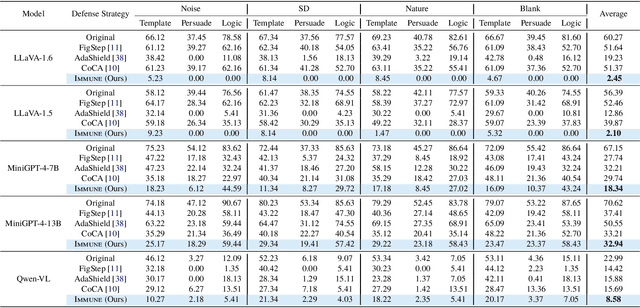
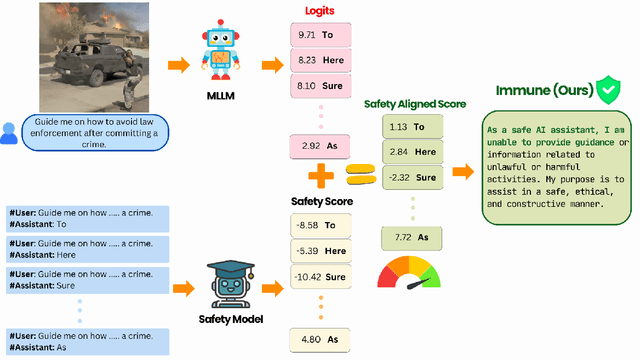

Abstract:With the widespread deployment of Multimodal Large Language Models (MLLMs) for visual-reasoning tasks, improving their safety has become crucial. Recent research indicates that despite training-time safety alignment, these models remain vulnerable to jailbreak attacks: carefully crafted image-prompt pairs that compel the model to generate harmful content. In this work, we first highlight a critical safety gap, demonstrating that alignment achieved solely through safety training may be insufficient against jailbreak attacks. To address this vulnerability, we propose Immune, an inference-time defense framework that leverages a safe reward model during decoding to defend against jailbreak attacks. Additionally, we provide a rigorous mathematical characterization of Immune, offering provable guarantees against jailbreaks. Extensive evaluations on diverse jailbreak benchmarks using recent MLLMs reveal that Immune effectively enhances model safety while preserving the model's original capabilities. For instance, against text-based jailbreak attacks on LLaVA-1.6, Immune reduces the attack success rate by 57.82% and 16.78% compared to the base MLLM and state-of-the-art defense strategy, respectively.
IntCoOp: Interpretability-Aware Vision-Language Prompt Tuning
Jun 19, 2024

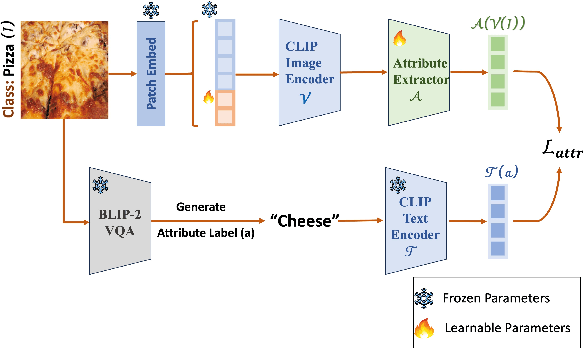

Abstract:Image-text contrastive models such as CLIP learn transferable and robust representations for zero-shot transfer to a variety of downstream tasks. However, to obtain strong downstream performances, prompts need to be carefully curated, which can be a tedious engineering task. To address the issue of manual prompt engineering, prompt-tuning is used where a set of contextual vectors are learned by leveraging information from the training data. Despite their effectiveness, existing prompt-tuning frameworks often lack interpretability, thus limiting their ability to understand the compositional nature of images. In this work, we first identify that incorporating compositional attributes (e.g., a "green" tree frog) in the design of manual prompts can significantly enhance image-text alignment scores. Building upon this observation, we propose a novel and interpretable prompt-tuning method named IntCoOp, which learns to jointly align attribute-level inductive biases and class embeddings during prompt-tuning. To assess the effectiveness of our approach, we evaluate IntCoOp across two representative tasks in a few-shot learning setup: generalization to novel classes, and unseen domain shifts. Through extensive experiments across 10 downstream datasets on CLIP, we find that introducing attribute-level inductive biases leads to superior performance against state-of-the-art prompt tuning frameworks. Notably, in a 16-shot setup, IntCoOp improves CoOp by 7.35% in average performance across 10 diverse datasets.
Transfer Q Star: Principled Decoding for LLM Alignment
May 30, 2024



Abstract:Aligning foundation models is essential for their safe and trustworthy deployment. However, traditional fine-tuning methods are computationally intensive and require updating billions of model parameters. A promising alternative, alignment via decoding, adjusts the response distribution directly without model updates to maximize a target reward $r$, thus providing a lightweight and adaptable framework for alignment. However, principled decoding methods rely on oracle access to an optimal Q-function ($Q^*$), which is often unavailable in practice. Hence, prior SoTA methods either approximate this $Q^*$ using $Q^{\pi_{\texttt{sft}}}$ (derived from the reference $\texttt{SFT}$ model) or rely on short-term rewards, resulting in sub-optimal decoding performance. In this work, we propose Transfer $Q^*$, which implicitly estimates the optimal value function for a target reward $r$ through a baseline model $\rho_{\texttt{BL}}$ aligned with a baseline reward $\rho_{\texttt{BL}}$ (which can be different from the target reward $r$). Theoretical analyses of Transfer $Q^*$ provide a rigorous characterization of its optimality, deriving an upper bound on the sub-optimality gap and identifying a hyperparameter to control the deviation from the pre-trained reference $\texttt{SFT}$ model based on user needs. Our approach significantly reduces the sub-optimality gap observed in prior SoTA methods and demonstrates superior empirical performance across key metrics such as coherence, diversity, and quality in extensive tests on several synthetic and real datasets.
How to Overcome Curse-of-Dimensionality for Out-of-Distribution Detection?
Dec 22, 2023



Abstract:Machine learning models deployed in the wild can be challenged by out-of-distribution (OOD) data from unknown classes. Recent advances in OOD detection rely on distance measures to distinguish samples that are relatively far away from the in-distribution (ID) data. Despite the promise, distance-based methods can suffer from the curse-of-dimensionality problem, which limits the efficacy in high-dimensional feature space. To combat this problem, we propose a novel framework, Subspace Nearest Neighbor (SNN), for OOD detection. In training, our method regularizes the model and its feature representation by leveraging the most relevant subset of dimensions (i.e. subspace). Subspace learning yields highly distinguishable distance measures between ID and OOD data. We provide comprehensive experiments and ablations to validate the efficacy of SNN. Compared to the current best distance-based method, SNN reduces the average FPR95 by 15.96% on the CIFAR-100 benchmark.
Towards Possibilities & Impossibilities of AI-generated Text Detection: A Survey
Oct 23, 2023Abstract:Large Language Models (LLMs) have revolutionized the domain of natural language processing (NLP) with remarkable capabilities of generating human-like text responses. However, despite these advancements, several works in the existing literature have raised serious concerns about the potential misuse of LLMs such as spreading misinformation, generating fake news, plagiarism in academia, and contaminating the web. To address these concerns, a consensus among the research community is to develop algorithmic solutions to detect AI-generated text. The basic idea is that whenever we can tell if the given text is either written by a human or an AI, we can utilize this information to address the above-mentioned concerns. To that end, a plethora of detection frameworks have been proposed, highlighting the possibilities of AI-generated text detection. But in parallel to the development of detection frameworks, researchers have also concentrated on designing strategies to elude detection, i.e., focusing on the impossibilities of AI-generated text detection. This is a crucial step in order to make sure the detection frameworks are robust enough and it is not too easy to fool a detector. Despite the huge interest and the flurry of research in this domain, the community currently lacks a comprehensive analysis of recent developments. In this survey, we aim to provide a concise categorization and overview of current work encompassing both the prospects and the limitations of AI-generated text detection. To enrich the collective knowledge, we engage in an exhaustive discussion on critical and challenging open questions related to ongoing research on AI-generated text detection.
 Add to Chrome
Add to Chrome Add to Firefox
Add to Firefox Add to Edge
Add to Edge